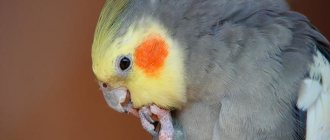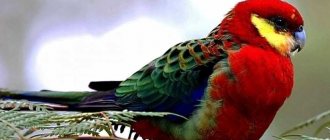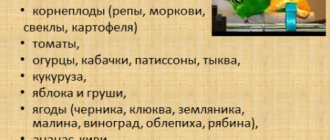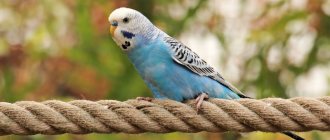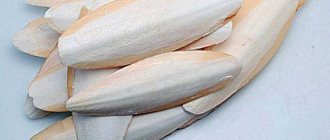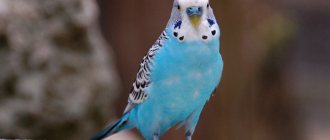Surely each of you would like your feathered pet to learn to parody human speech and pronounce at least a few simple phrases as quickly as possible. To do this, you should initially have a parrot like a gray parrot.
Teaching a Gray to talk is as easy as shelling pears. These birds, despite their unsightly gray plumage, are very intelligent and talented. They can rightfully be considered the intellectuals among parrots.
Taming before starting training
Of course, of all talkers, Grays are the best. They always adopt human words, it doesn’t even depend on age. A chick can be taught at home quickly and purposefully, and an adult can be taught with a little more effort, but also successfully.
Taming a parrot before training it
Even the gender of the student does not play any role. Immediately after acquisition, there is no need to torment the parrot with lessons; let it look around, get accustomed, and choose an owner from among the family members.
And this preference does not at all depend on who gives him food and spends more time with him. An incident from life - one day Gray chose a Doberman, which relatives sometimes brought to visit him, and after a while he barked so much that he scared away all the robbers.
Read also
Keeping a Gray at home
In any case, it is necessary to tame the parrot as best as possible before starting classes. Let him show interest in communicating with the owner and not feel any fear. Then the bird will be attentive and remember the words perfectly.
As already mentioned, the owner’s mood cannot be hidden from the pet. You need to always be cheerful, kind, cheerful, and he will respond warmly. Attention to the student’s mood is also important. He should not fall asleep on the fly, ask for food or rush around the room in search of adventure. It is better to use the moment for learning when he is focused and calm.
Lifespan and reproduction in captivity
Under favorable conditions and proper care, Grays can live 30-50 years.
African gray parrots breed well in captivity and, when kept at home, reach sexual maturity at the age of 3 years. The breeding season of Grays lasts from late spring to early autumn.
It is better to introduce parrots on neutral territory, in a spacious enclosure. First, the Grays are left alone for a couple of hours, and then they are separated and after a while they again organize a walk together. If the birds like each other, they are housed together.
In order for gray breeding to be successful, a nesting house measuring 30 x 30 x 30 cm is placed in the couple’s cage. Some time after mating, the female lays 3-4 eggs and hatches them for a month. The chicks are born blind and covered with gray down. They begin to see in the 3rd week of life and eat what their parents give.
The female remains in the nest all this time, and the male takes care of food for the family. After the chicks turn 3 months old, they begin to fly out, but remain under the supervision of their elders for some time.
Where to start teaching Grays to speak?
First of all, you need to love your pupil, always talk to him emotionally, affectionately, being completely enchanted by his unique beauty and sociability. If the only goal is to own a talkative parrot, it is better to refuse the purchase altogether, since very often the owner, who is determined to receive a sensation, suffers a complete fiasco. A pet needs love and trust, only then does it become responsive. And you need to start your lessons with short, most ordinary words.
Where to start to teach a Gray to speak
Recommendations before purchasing
Jaco is smart and emotional, he develops a strong character. Therefore, it is not recommended to buy it for people who do not know how to properly care for it. If you really want to communicate with an intellectual ward, you need to first learn about the rules of detention.
How to choose an African parrot:
- It is better to buy a young bird, no older than 3–4 months.
- If the chick is older than the age specified in the first paragraph, it must be tame.
- It is preferable to purchase from a specialized nursery rather than from an advertisement.
The bird can be purchased together with an equipped cage.
Techniques for teaching simple words
There are numerous techniques, they are accessible and very effective. However, without an emotional component, a teacher will not achieve success. Even the simplest words in the first lessons should be pronounced with a gentle intonation: “Gosh is good”, “Hello, Gosha!”, “Kesha, bye!”, “Dasha, how are you?”
A parrot can have absolutely any name, although it is believed that the presence of a hissing sound in it accompanies success in mastering speech. And you should always talk to your pet, from the very first minute, constantly calling him by name, then the transition to the lesson itself will be made smoothly.
When communicating with a bird, tactile contact is desirable. I always stroke my Gray when we talk, no matter where he is: in a cage on a perch, or on my shoulder. Even when doing ordinary household chores, it is better to comment on them out loud: “Gosha needs to eat!” (if I pour food), “It’s time to wash!” (when the bath is ready), “Now it’s clean!” (during cleaning).
Parrot training technique forgive words
I didn’t even think that the parrot listened to and remembered everything, and I was very surprised by these “incidental” phrases a year and a half later. The owner needs to be patient and not stop practicing; his efforts will definitely be rewarded over time. Most often, the first word of a gray parrot is its name. Our Gosha said “eat.” And it was great joy!
Kinds
Today, 3 varieties of these birds are known.
- Brown-tailed animals. Compared to other subspecies, they are smaller in size (about 300 mm).
- Redtails. The light gray plumage contrasts with the bright red tail. Among African tribes this color was considered lucky, so the birds were hunted mercilessly. Body length is about 370 mm.
- Royal look. They are also called Ghanaian Princess Grays. Extraordinarily beautiful birds with red splashes among their gray feathers. The first mention of them dates back to 1909.
There are known cases of artificial breeding of birds with unusual plumage colors: pinkish, yellow or albino.
How to properly reward a bird for success?
The main thing is to praise the parrot, always do it affectionately and with soul, because he will sense the slightest pretense or insincerity. Even if there is no audible result yet, it is clear that the bird is listening, it is attentive, it is necessary to encourage it even more emotionally and actively with words. And be sure to give some kind of treat, for example, your favorite seeds.
However, if the student does not have confidence in the teacher, nothing good will come of joint activities. You need to become a companion, a best friend, only then mutual understanding arises. A parrot copies all the actions of a person it likes, and this includes not only behavior, but also spoken words.
Jaco (savage) 2nd day since he started talking)) Kuuurochka, oh))
You must not violate your pet's personal area. Sudden movements can frighten him, or at least alert him. Don't even say words of encouragement too loudly. Long classes also do not make sense. Five or ten minutes is enough. And the owner himself will probably get tired of repeating the same word.
Parrot diseases
Diseases of parrots are conventionally divided into three types: non-contagious, infectious and parasitic.
Non-communicable diseases include:
- Self-plucking is a common phenomenon that occurs due to fright, poor diet, stress from drafts, dry air, and parasite infestation. The result of this disease is the habit of plucking feathers, as a result of which Jaco can practically lose his plumage. Treatment is to eliminate the cause of the disease. In advanced states, this process, unfortunately, is irreversible.
- Obesity can occur due to the inclusion of animal products in the diet, as well as the abundance of oilseeds (for example, sunflower seeds). Obesity can lead to shortness of breath, inability to reproduce, cirrhosis of the liver, and decreased mobility.
- Constipation in parrots can occur as a consequence of obesity, infection with parasites, or poor quality food. For treatment, a couple of drops of vegetable oil are injected into the anus using a pipette or castor oil is instilled into the beak.
Among the parasites in parrots, the most common are helminths and feather eaters. Worms can cause exhaustion and even death of the bird. They appear due to non-compliance with hygiene rules and the parrot eating dirty food. For treatment, you must contact a veterinarian. Down feather eaters feed on the epidermis, down, blood, and feather barbs. A parrot affected by them becomes disheveled, its sleep is disturbed and its appetite is lost. To completely get rid of them, the cell must be treated with insecticides.
Infections can occur through insect bites, contaminated food, water, droppings, or contact with sick birds. The most common infectious disease is paratyphoid or salmonellosis. Sulfapyridazine powder is mainly prescribed as treatment. Aspergillosis is caused by molds. Symptoms of this disease: discharge from the nostrils, thirst, diarrhea, rapid breathing. Parrots are susceptible to tuberculosis, the bird begins to lose weight, often yawns and coughs.
How to teach a Gray to pronounce complex sentences?
It’s better not to plan for a quick result, because it doesn’t happen. A parrot's training depends on too many different factors. No one knows which phrase the student will like so much that he will want to copy it. But if you include already learned words in the sentence, things will go faster.
Read also
How to equip a cage for a budgie
Success does not come immediately. But the Gray will instantly repeat the phrases spoken by the owner in his hearts. The bird will remember and reproduce them precisely because “shameful” expressions are filled with particularly strong emotions. Therefore, in the presence of a parrot, you must always be restrained.
Mechanically copying the owner is not so interesting. But if he puts his soul into training, the pet is able to sing songs and respond to the topic. One hundred learned words is not the limit for him; moreover, he can use long phrases with complex phrases and phrases, comparing them with surrounding objects, with shape, color.
Jaco. First lessons. Learning colors.
Onomatopoeia is only part of talent. Jaco perfectly imitates the creaking of doors, the melody of a mobile phone, and the car signal under the windows. The repertoire of a bird living in good conditions can be exceptionally large.
Description
Grays are also known as African gray parrots. The body of these birds is quite large (300-350 mm), the length of the wingspan is 650 mm. The beak is curved, black in color, quite strong and large enough to handle hard food. The cere and nostrils are yellowish, contrasting beautifully with the beak. The color of the iris is yellow. Chicks have black eyes; as they mature, the iris becomes lighter. The edging of the eyes is gray, devoid of feathers. The shade of the legs is silvery-ashy, their surface is covered with tiny scales.
The feathers are not thick. Externally, the plumage is somewhat similar to the scales of snakes. Females are distinguished by their smaller size, dome-shaped head and relatively small, neat beak. It is quite difficult for an ignorant person to determine the sex of a bird, and after one and a half years it is almost impossible.
They are excellent imitators, masterfully imitating the sounds of the human voice. He is able to memorize up to 1.5 thousand words, speaks out in fairly meaningful sentences, and loves to engage in dialogue.
